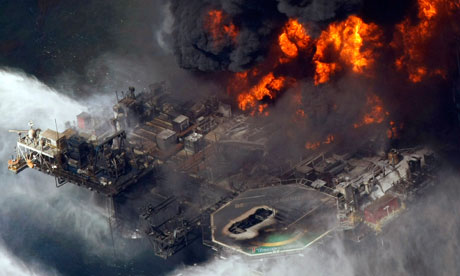BP had little defence against a disaster, federal investigation says
by editor | 2010-11-09 9:05 am
![]()
Federal investigation into Deepwater Horizon oil disaster says BP overlooked warning signs

The presidential commission investigating the Gulf of Mexico oil disaster ran into controversy today by saying it had found no evidence that BPand other oil companies put profits ahead of safety on the Deepwater Horizon rig. In a preliminary finding by what is the first independent panel, the commission’s chief investigator found a series of missed warning signs before the April 20 explosion on the rig. Fred Bartlit said repeatedly that he had found no evidence to justify claims that BP and others on the Deepwater Horizon took shortcuts on safety to save money: “To date, we have not found a single instance where human beings made a conscious decision to favour dollars over safety.” Bartlit, appointed by Barak Obama, had led the investigation into the 1988 Piper Alpha disaster in the North Sea, when 167 workers died. He was immediately accused by lawyers for Deepwater Horizon victims, environmentalists and Democrats in Congress of letting the oil company off the hook. But in an angry session with reporters he insisted he was not clearing BP, Transocean and Halliburton of responsibility for the disaster. “Any time you are talking about $1.5m a day, money enters into it. All I am saying is that human beings did not sit there and sell human safety down the river for dollars that night,” he said. Bartlit complained repeatedly during his presentation that he did not have subpoena powers and had to rely on the goodwill of oil firm.”I wish I had that power because I think it’s damned important — but that’s the way it goes,” he said. The Senate refused to grant such powers. The commission’s version of events, which agreed 90% with the conclusions of BP’s internal investigations, runs counter to the narrative developed in congressional investigations that the firm regularly took safety short cuts to save money. “When the culture of a company favours risk-taking and cutting corners above other concerns, systemic failures like this oil spill disaster result without direct decisions being made or trade-offs being considered,” Ed Markey, a Democratic congressman who led investigations into the spill, said in a statement. In a long and detailed re-enactment of events leading up to the explosion, Bartlit and his team outlined a clear trail where disaster could have been averted. The team also questioned executives from BP, Transocean and Halliburton. The investigation produced 13 findings on the path to the disaster. Eleven men died when the rig exploded, releasing nearly 5m barrels of oil and gas into the Gulf of Mexico. The Macondo well was from the start a challenging one. BP had intended to drill even deeper but stopped at 18,360ft because of the difficulties of preventing oil seeping into the surrounding rock. But despite those early difficulties BP, Transocean, and Halliburton overlooked warning signs several times during drilling. The investigation singled out the crew’s decision to overlook the results of a negative pressure test on the well, hours before the 20 April explosion, which showed a faulty cement seal. “The well was flowing. Hydrocarbons were leaking, but for whatever reason the crew after three hours … that night decided it was a good negative pressure test,” said Sean Grimsley, Bartlit’s associate. “The question is, why these experienced men out on that rig talked themselves into believing that was a good test which established well integrity.” The failure is even more striking given BP and Halliburton knew by 20 April that the cement seal on the well was defective.”People knew there was one barrier. The well was under-balanced and that called for heightened high vigilance,” Grimsley said. “People knew you had to be really careful.”
The findings included:
• The cement seal at the bottom of the well failed to hold back oil and gas in the reservoir, and should have been redesigned. • BP and Transocean interpreted the failed negative pressure test as a success. • BP introduced additional safety risks in its plan to shut down the drilling rig. • Crews on the rig and in offshore offices should have picked up warnings on monitors that gas was rising from the well. • Rapid response at that time could have prevented a blowout. Many conclusions mirror those of BP’s internal investigation, and Bartlit said he agreed with 90% of it. The most significant conclusions for BP could be the finding that the leak rose through the drill pipe rather than the space between the casing and the rock formation. That supports BP’s contention that its well design was not a contributing factor in the explosion. Some analysts have said BP’s choice of a “long string” well design – which was cheaper – increased the risk of oil and gas escaping the pipe. But Bartlit said he was inclined to agree with BP. Yesterday’s session was the most dramatic of the five public hearings, as Bartlit strode across the floor, holding up pieces of drilling equipment. The commission is to produce its final report on 11 January. By its own admission, the commission’s investigations are not exhaustive. He admitted at times he was unable to come to a conclusion when faced with different versions of events from BP, Transocean, Halliburton and the other oil companies involved.
Source URL: https://globalrights.info/2010/11/bp-had-little-defence-against-a-disaster-federal-investigation-says/